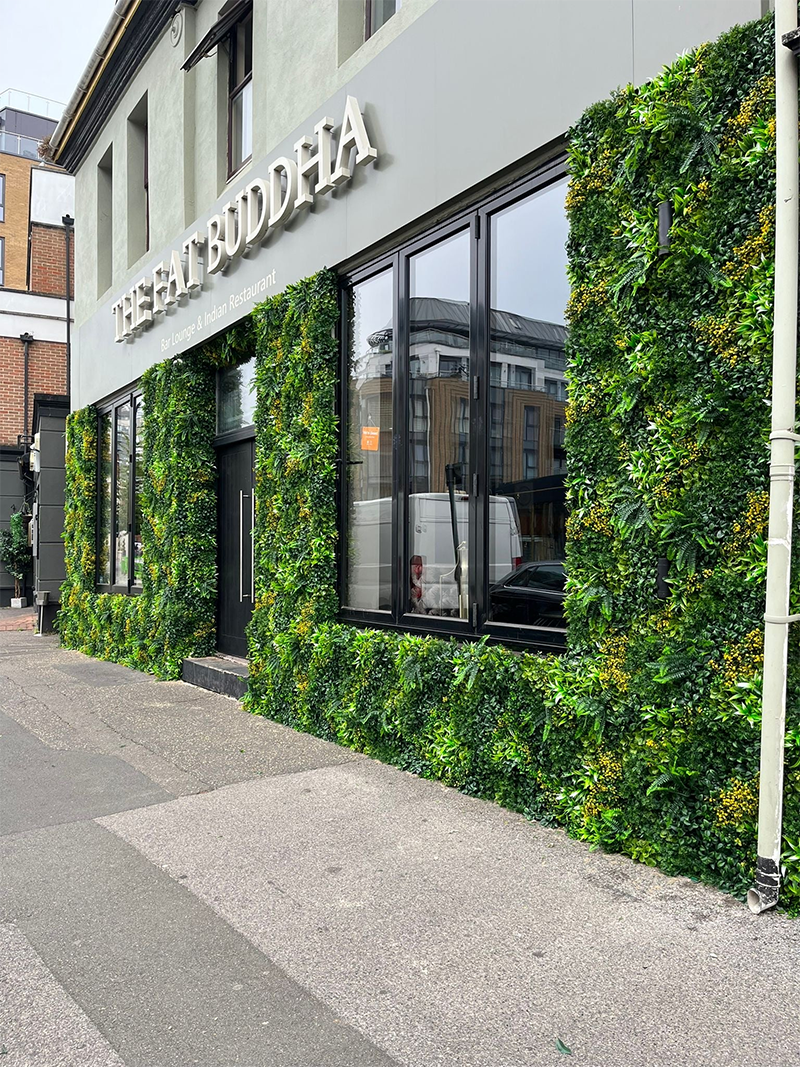As urbanization accelerates, the integration of green infrastructure into cities has become critical for mitigating environmental challenges. 3D artificial vertical gardens have emerged as a scalable solution, offering multifaceted ecological benefits. This article examines their impact on air quality, thermal regulation, biodiversity, and noise reduction, providing insights into their role in sustainable urban development.
Vertical gardens act as natural air filters, capturing particulate matter (PM) and absorbing gaseous pollutants. Studies indicate that vegetation can reduce PM concentrations by 20–30% in urban areas, with leaves trapping dust, pollen, and soot. Additionally, plants absorb harmful gases like nitrogen dioxide (NO₂) and sulfur dioxide (SO₂) through their stomata, converting them into harmless compounds. For example, ferns and spider plants are particularly effective at removing formaldehyde and benzene, common indoor pollutants.
The substrate and soil within vertical gardens also contribute to air purification. Microorganisms in the soil break down volatile organic compounds (VOCs), while the moisture retained by the substrate enhances the plants’ ability to absorb pollutants. In dense urban areas, vertical gardens near highways or industrial zones can significantly reduce the dispersion of pollutants into residential areas, improving air quality for nearby communities.
One of the most notable ecological benefits of vertical gardens is their ability to mitigate the urban heat island effect. By shading building surfaces and absorbing solar radiation, these installations can lower surface temperatures by 2–6°C. The evapotranspiration process further cools the surrounding air, with some studies reporting temperature reductions of up to 8°C in areas with dense vertical gardens.
This cooling effect translates into energy savings for buildings. By reducing the need for air conditioning, vertical gardens can lower energy consumption and associated greenhouse gas emissions. For instance, a study on a commercial building in Singapore found that a vertical garden reduced indoor temperatures by 3–4°C, leading to a 15% decrease in cooling energy use. Additionally, the insulation provided by vertical gardens in winter can reduce heating demands, enhancing overall energy efficiency.
Vertical gardens create microhabitats for urban wildlife, supporting biodiversity in otherwise sterile environments. The diverse plant species in these gardens attract pollinators like bees and butterflies, as well as birds and insects that rely on vegetation for food and shelter. For example, the "Vertical Forest" in Milan, Italy, hosts over 730 trees, 5,000 shrubs, and 15,000 groundcover plants, providing a haven for urban wildlife.
These green spaces also contribute to ecosystem services such as soil stabilization and water retention. The root systems of plants in vertical gardens help bind soil, reducing erosion on building facades. Additionally, the moisture-retaining properties of the substrate can mitigate stormwater runoff, alleviating pressure on urban drainage systems. By fostering biodiversity and providing ecosystem services, vertical gardens play a crucial role in enhancing urban resilience.
The dense foliage of vertical gardens acts as a natural sound barrier, absorbing and deflecting noise pollution. Studies have shown that vertical gardens can reduce noise levels by 6–8 decibels, a reduction comparable to traditional soundproofing materials. The leaves and stems of plants scatter sound waves, while the substrate and air pockets within the garden structure further dampen vibrations.
In urban areas, vertical gardens can be strategically placed near highways, railways, or industrial zones to shield residential and commercial buildings from noise intrusion. For example, planting vertical gardens along elevated highways can significantly reduce traffic noise for nearby communities. Additionally, in offices or schools, vertical gardens can create quieter indoor environments by absorbing background noise and improving acoustic comfort.
The ecological benefits of 3D artificial vertical gardens are far-reaching, addressing key urban environmental challenges such as air pollution, heat islands, and biodiversity loss. By integrating these installations into building facades and public spaces, cities can enhance sustainability, improve quality of life, and foster a deeper connection between people and nature. As technology advances, the design and maintenance of vertical gardens will continue to evolve, offering even greater ecological and social value in the future.

Contact: Amy
Phone: 86-15311787313
E-mail: info@foszmac.com
Whatsapp:86-15311787313
Add: Fengtai District, Dacheng Road, No.24 Building, Room 203, Beijing, China